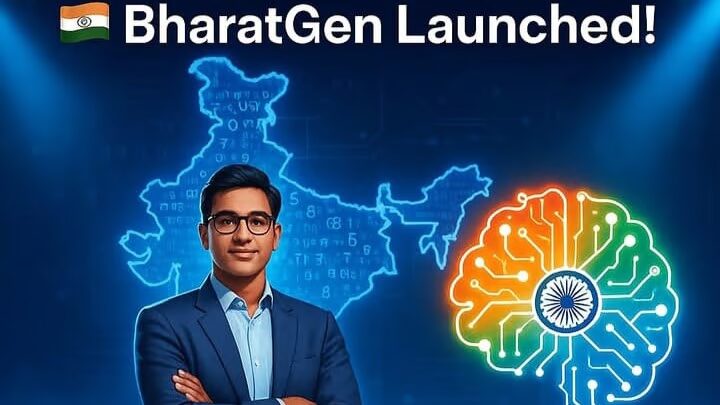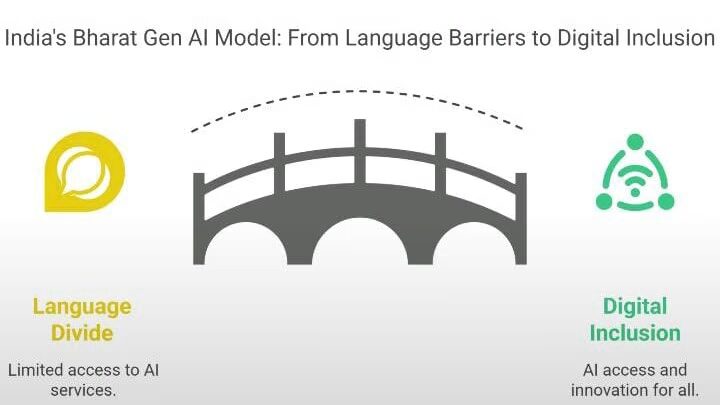
A tale about AI-in-pursuing history began at the very instance when a nation of 1.4 billion people and home to 22 officially recognised languages and hundreds of dialects, started the journey of creating BharatGen.
Union Minister-Dr. Jitendra Singh announced BharatGen in June 2025, at the BharatGen Summit held in New Delhi, as India’s first government-funded multimodal large language model (LLM). The project was carried out with the guidance of the National Mission on Interdisciplinary Cyber-Physical Systems of the Department of Science and Technology (DoST).
BharatGen will democratise the sphere of AI at the intersection of text, speech, and image processing, thereby making the technology available to fellow Indians in their language. Unlike most other global LLMs, which tend to revolve around the English language, BharatGen has been specifically built to cater to the multilingual and multicultural diversity of India.
ALSO READ- Operation Spider Web: Ukraine’s Deep Strike into Russia
Significance: Why BharatGen Matters-
1. Linguistic Inclusivity:
- It is an essential part of BharatGen which majorly targets its multilingual population.
- Hindi, Tamil, Bengali, Assamese, Telugu, Malayalam, Punjabi, Marathi list goes on, with over 22 Indian languages supported.
- It closes the digital gap for millions of users unable to comprehend the English language.
Regional languages that generally remain under the radar of international AI development are preserved and digitised by this initiative.
2. Multimodal Capabilities:
BharatGen is not restricted to a mere translation of dialects. It is classified as a full multimodal AI platform that allows for understanding and operational applications in the following ways:
- Text: Original language comprehension and its generation.
- Speech: Voice command and voice-to-written text capabilities in various languages.
- Images: Captioning AI enhanced for images, recognising them in natural language.
It would form the foundation for future regional voice assistants, AI tutors, and inclusion-based digital services.
History: Genesis of BharatGen-
The inception of BharatGen was a realisation that the current models of AI worldwide are not geared to serve a heterogeneous India.
- Conceptualisation: In early 2023, policymakers and technologists understood the need for a localised, so-called inclusive ethical artificial intelligence ecosystem.
- Development: IIT Bombay led this multi-faceted multinational effort with coordination from AI researchers, linguists, and computer engineers.
- Launch: After rigorous testing and pilot programs, BharatGen was officially launched on June 2, 2025, at a summit where academicians, industry leaders, and government officials convened.
How BharatGen Works?

1. Multimodal Integration:
BharatGen articulates cutting-edge machine learning designs very well.
- To support verbal-to-text and text-to-speech skills in the regional languages.
- To provide voice-enabled services, especially for rural and visually challenged users.
- It will help in image processing, including real-time subtitles and translation of image-based content in the local script.
2. Language Processing Engine:
BharatGen has been trained on vast language datasets that were garnered from literature, newspapers, educational material, and speech data in Indian languages.
Contextual understanding, deriving from idioms, cultural references, and semantics, allows context-sensitive real-time translations from one language into another to escape the rigid literalism of conventional translation tools.
3. Open Source Framework:
Because the BharatGen model has an open-source license for contributions from developers, AI start-ups, and universities into the model, projects may be harnessed for some specific domains, such as healthcare, education or agriculture.
It forms a collaborative ecosystem characterised by regular innovation and localisation.
Applications Across Key Sectors-
Healthcare:
AI medical chatbots could be developed through BharatGen, which would offer health advice in local languages.
Further facilitates such a means of communication between doctors and patients across countries where telemedicine is part of the system.
Helps in empowering the public wellness department to execute campaigns in all languages for additional influence.
Education:
Personalise learning tools for pupils based on their personal language preferences. It can translate textbooks and online courses, while teachers can use BharatGen to prepare their multilingual study materials and assessments.
Governance:
These public service portals are integrated with BharatGen to offer services in a native language for the citizens. Real-time translation of simple official documents, notices, and government schemes can be achieved through this.
This makes the governance a lot more people-friendly and inclusive.
Farming:
Helps disseminate farm advice, bad weather alerts, and crop price updates via local languages. AI-mediated suggestions about irrigation, pest management, and seasonal crops should be provided to rural farmers.
Local content will increase awareness and education about sustainable practices.
Future Prospects-
BharatGen envisions far more than 22 languages in the future. The future goals would be:
- To add more dialects and rare languages from tribal and isolated communities.
- Collaborate with industries to create AI applications for finance, law, logistics, and customer service.
- Investing in R&D to improve natural language reasoning, translation quality, and multimodal learning.
- Also, exploring imposing BharatGen globally within the model of an AI in linguistically diverse nations.
Real-World Impact and Global Attention-
BharatGen is fast making headlines for its localisation approach for developing artificial intelligence. BharatGen agrees that the Western AI models treat languages as a formal structure; they help in understanding the Indian way of learning about the social, emotional, and contextual aspects of communication.
- This initiative will encourage cross-border collaborations for inclusive AI design.
- Tech communities support BharatGen’s open development ethos, which is culturally aware.
- As such, BharatGen stops at nothing less than a game-changer on behalf of AI here in India.
- BharatGen is poised to be a model for other multilingual countries.
- Across the world, researchers are studying the ethics-first framework of BharatGen.
- If successful, this could enhance India’s stature in the global AI economy quite a lot.
Putting Forth BharatGen’s Promise for India-
In an increasingly digital world, the opportunities BharatGen confers upon India to make technology truly inclusive are rare. BharatGen, by accommodating diverse languages and cultures, lays down the premise for a digital Bharat that is not only high on technology but also on linguistic and social equity.
As it evolves, BharatGen will reshape how nations develop AI: not as rigid solutions for all but as a human-centred ecosystem.
BharatGen is more than an LLM for India. It is a new spectre of involvement of AI, made in India, for India, for the universe.
